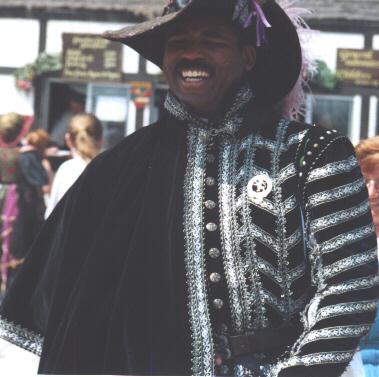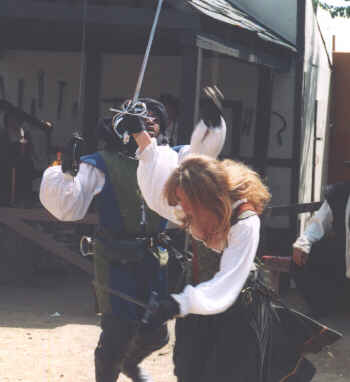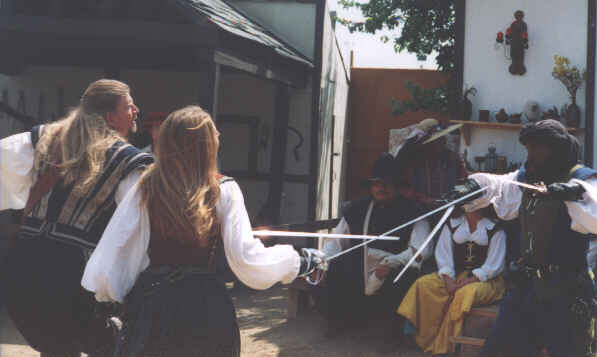
I traveled twice to the Faire this year. Once was with my young pal Alex, who used my booklets to make a costume for history class. The second time was with my friend Garrett, for whom I had the privilege of performing sign language interpretation in this his senior year of high school.
 |
This man greeted travelers outside the gates of the town. You can't see it, but three ladies are standing behind this man, lifting his cape and taking pictures. I must assume they wanted details of the exquisite embroidery, but should this man's WIFE have found him thus, he'd have those stripes on his HIDE! |
| Here now is a sporting duel in front of a tavern at the town gate. The woman fighting our challenger is as quick with her blades as her wit. But she is not alone in the challenge. In his hubris, the upstart took on two champions: This woman and her rogueish companion. |  |
 |
The duel lasted a good stretch of time, the challenger very able to take each in turn. But by those turns things fell out so that he faced two at once. This was the beginning of the end for him. He was able to turn their four blades aside with his two, but only once, showing here. The next block and parry left him wide open to the rogue on the left, and he admitted the point of their argument. |
| Here is a congregation of nobles attending the morning service. Notice the pillows for kneeling. Notice also that the townsfolk behind them are patently ignoring the service. It was rather funny that while the above duel was taking place, so was the church service. At one point between contests at the tavern, a rather abrasive-voiced woman pushed through the crowd calling her husband's name. He was in the tavern. She found him and pulled him by the ear over to the service, and not all the blades in the world could have stopped her! |  |
| Here is a good picture of the distinction between the garb nobels wore,
and the peasantry. These are the Washer women, eternal gossips who watch the comings and goings in the town while doing laundry in the spring. Rather a scary thought that: washing clothes in the town spring! At least the soaps were natural. |
 |
Look at the difference in the garb of these women compared to the noble women above. The fabrics are much less expensive; the design simpler, sometimes years behind the latest court fashions. Of course, the Renaissance Faires now are presenting history as we think it SHOULD have been, you might see peasants or middle-class people with heavily embroidered garb (against the sumptuary laws of the time BTW) or in colors much to vivid for the vegetable dyes they used. So these washer women are a GOOD example of what is right and proper clothing for their class.
Even the deep, ruby red skirt is 'possible' with vegetable and berry dyes, though it would take many repeated steps to achieve. It would be the pinnacle of allowable fashion for peasants, but that quality of color would be the general rule for the middle class.
Indigo blue was more common, like the woman's skirt on the far right. But it was the color worn by apprentices and servants, so if you are going as a rich merchant, do not wear indigo.
Next page Previous Page Homepage